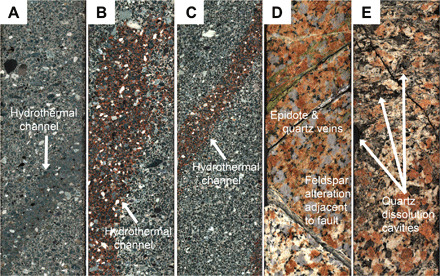Fig. 2. Hydrothermally altered rock.

Sawn surfaces through hydrothermally altered core samples, 83 mm wide. (A) Dark green porous, permeable channel that cuts through an impact melt-bearing breccia (suevite). The matrix of the breccia was dissolved before being partially replaced by secondary carbonate that grew from the fluid. Sample 007A-48R-3, 40 to 70 cm (643 mbsf). (B and C) Red-orange swath of Na-dachiardite and analcime cutting through impact melt-bearing breccia. The carbonate matrix of the breccia was dissolved in the hydrothermal channel, before Na-dachiardite, analcime, clay, and sparry calcite partially filled the channel. Samples 0077A-53R-3, 0 to 30 cm (658 mbsf), and 0077A-54R-1, 50 to 80 cm (660 mbsf). (D) Highly deformed, porous, and permeable peak-ring granitoid rock cut by a fault adjacent to altered feldspar and veins partly filled with quartz and epidote. Sample 0077A-129R-2, 0 to 30 cm (832 mbsf). (E) Granitoid rock with centimeter-size quartz dissolution cavities. Sample 0077A-275R-2, 0 to 30 cm (1248 mbsf).
